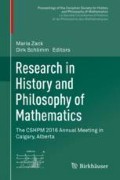Abstract
We present a sound and complete Fitch-style natural deduction system for an S5 modal logic containing an actuality operator, a diagonal necessity operator, and a diagonal possibility operator. The logic is two-dimensional, where we evaluate sentences with respect to both an actual world (first dimension) and a world of evaluation (second dimension). The diagonal necessity operator behaves as a quantifier over every point on the diagonal between actual worlds and worlds of evaluation, while the diagonal possibility quantifies over some point on the diagonal. Thus, they are just like the epistemic operators for apriority and its dual. We take this extension of Fitch’s familiar derivation system to be a very natural one, since the new rules and labeled lines hereby introduced preserve the structure of Fitch’s own rules for the modal case.
Notes
- 1.
If we can say that these constitute a single research program at all. In any case, Chalmers (2004) provides a nice account of how exactly most of these differ.
- 2.
The exception is Restall (2012), as mentioned below.
- 3.
Thereby relegating □ to superficial necessity. Strictly speaking, the axiomatic system in Davies and Humberstone (1980) does not contain a diagonal operator, but a ‘fixedly’ operator, \(\mathcal{F}\), which alongside an actuality operator, \(\mathcal{A}\), generates truth on the diagonal. It is with respect to \(\mathcal{FA}\) that deep necessity is defined. For more on the notions of deep and superficial necessity, see Evans (1979).
- 4.
Note that (S) holds at every world considered as actual, since in these worlds ‘Julius’ always picks out the actual inventor of the zip. If, by contrast, the actual world is held fixed, and we only consider different possible worlds relative to this world as the actual one, then there will be pairs at which (S) is false—precisely those in which the inventor of the zip differs from the actual one.
- 5.
We purposefully conflate use/mention when the context is clear to avoid cluttering the paper.
- 6.
In Lampert (forthcoming) we present several prefixed tableau systems for different two-dimensional modal logics.
- 7.
For a discussion on different accounts of validity in two-dimensional logics, see Lampert (forthcoming).
- 8.
Strictly, axiom-schemata.
- 9.
Fritz does not list \(\mathcal{A}1\) between the axioms, but this appears in Crossley and Humberstone’s original formulation (1977, p. 14).
- 10.
These are the rules where no new scope line is opened in the elimination of \(\mathcal{D}\) and the introduction of \(\mathcal{C}\), respectively.
References
Chalmers, D (1996) The Conscious Mind: In Search of a Fundamental Theory. Oxford University Press.
Chalmers, D (2004) Epistemic Two-Dimensional Semantics. Philosophical Studies, 118, 153–226.
Crossley, JN and Humberstone, L (1977) The logic of “actually”. Reports on Mathematical Logic 8, 11–29.
Davies, M and Humberstone, L (1980) Two notions of necessity. Philosophical Studies, 38(1), 1–30.
Evans, G (1979) Reference and Contingency. The Monist, 62, 161–189.
Fitch, FB (1952) Symbolic Logic: an Introduction. New York: Ronald Press, Co.
Fritz, P (2013) A logic for epistemic two-dimensional semantics. Synthese, 190, 1753–1770.
Fritz, P (2014) What is the correct logic of necessity, actuality, and apriority? The Review of Symbolic Logic, 7(3), 385–414.
Hazen, AP (1978) The eliminability of the actuality operator in propositional modal logic. Notre Dame Journal of Formal Logic, 4, 617–622.
Jackson F (1998) From Metaphysics to Ethics: A Defense of Conceptual Analysis. Oxford University Press.
Kaplan, D (1989) Demonstratives. In Almog J, Perry J and Wettstein H (Eds.), Themes from Kaplan (pp. 481–563). Oxford: Oxford University Press.
Kripke, S (1980) Naming and necessity. Cambridge, MA: Harvard University Press. Lampert, F (forthcoming) Actuality, tableaux, and two-dimensional modal logics. Erkenntnis.
Restall, G (2012) A cut-free sequent system for two-dimensional modal logic, and why it matters. Annals of Pure and Applied Logic, 163, 1611–1623.
Stalnaker, RC (1978) Assertion. In Cole P (Ed.), Syntax and Semantics: Pragmatics (Vol. 9, pp. 315–339). New York: Academic Press.
Acknowledgements
Thanks to Alexander Kocurek, Andrew Parisi, Shawn Standefer, the UC Davis Llemma group, and two anonymous reviewers for comments on earlier drafts that greatly improved this paper.
Author information
Authors and Affiliations
Corresponding author
Editor information
Editors and Affiliations
Rights and permissions
Copyright information
© 2017 Springer International Publishing Switzerland
About this paper
Cite this paper
Lampert, F. (2017). Natural Deduction for Diagonal Operators. In: Zack, M., Schlimm, D. (eds) Research in History and Philosophy of Mathematics. CSHPM 2016. Proceedings of the Canadian Society for History and Philosophy of Mathematics/La Société Canadienne d’Histoire et de Philosophie des Mathématiques. Birkhäuser, Cham. https://doi.org/10.1007/978-3-319-64551-3_3
Download citation
DOI: https://doi.org/10.1007/978-3-319-64551-3_3
Published:
Publisher Name: Birkhäuser, Cham
Print ISBN: 978-3-319-64092-1
Online ISBN: 978-3-319-64551-3
eBook Packages: Mathematics and StatisticsMathematics and Statistics (R0)

